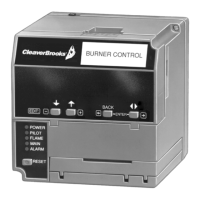CB780/CB784 RELAY MODULES
29 32-00207—01
4. Initial lightoff check for direct spark ignition of oil—
all burners using DSI.
5. Pilot turndown test—all installations using a pilot.
6. Hot refractory saturation test—all installations using
Infrared (lead sulfide) Flame Detectors.
7. Hot refractory hold-in test—all installations.
8. Ignition interference test—all installations using
flame rods.
9. Ignition spark pickup—all installations using Ultravi-
olet Flame Detectors.
10. Response to other ultraviolet sources—all installa-
tions using Ultraviolet Flame Detectors.
11. Flame signal with hot combustion chamber—all
installations.
12. Safety shutdown tests—all installations.
See Figs. 1 and 2 for location of component parts and Fig.
7 or wiring subbase specifications for terminal locations.
Preliminary Inspection
Perform the following inspections to avoid common
problems. Make certain that:
1. Wiring connections are correct and all terminal
screws are tight.
2. Flame detector(s) is clean, and installed and posi-
tioned properly. Consult the applicable instructions.
3. Correct combination of amplifier and flame detec-
tor(s) is used. See Table 2 in the Specifications sec-
tion.
4. Plug-in amplifier and purge card are securely in
place.
5. Burner is completely installed and ready to fire; con-
sult equipment manufacturer instructions. Fuel
lines are purged of air.
6. Combustion chamber and flues are clear of fuel and
fuel vapor.
7. Power is connected to the system disconnect switch,
(master switch).
8. Lockout is reset (push in reset button) only if the
Relay Module is powered; see Figs. 1 and 2.
9. Run/Test Switch is in RUN position.
10. System is in the STANDBY condition. STANDBY mes-
sage is viewable in the VFD.
11. All limits and interlocks are reset.
Flame Signal Measurement (Table
9 and Fig. 25)
Measure the flame signal at the appropriate times as
defined in the following Checkout tests. Read the flame
signal in volts dc at the flame amplifier test jacks + and
(Com) or at the Keyboard Display Module.
1. Use one megohm/volt meter with a 0 to 10 Vdc
capability.
2. Set the one megohm/volt meter to the 0 to 10 Vdc
range.
3. Insert the positive (red) probe into the + jack of the
flame amplifier. Insert the negative (black) probe
into the (Com) jack of the flame amplifier; see Fig.
25.
4. Allow a few seconds for the meter reading to stabi-
lize.
5. If using AMPLI-CHECK™ or shutter check amplifiers,
read the average stable voltage, disregarding the
peaks and valleys caused by the self-checking oper-
ation.
6. The meter reading must be as specified in Table 8
after all tests are completed and all adjustments
made.
As an option, the flame signal can be checked by using the
Keyboard Display Module.
If the signal is unstable or less than the minimum
acceptable voltage, check flame detector installation and
circuitry.
1. Check the supply voltages at terminals 4 (L1) and L2
(N). Make sure the master switch is closed, connec-
tions are correct, and the power supply is of the cor-
rect voltage, frequency and is sinusoidal.
2. Check the detector wiring for defects including:
a. Incorrect connections.
b. Wrong type of wire.
c. Open circuits.•Deteriorated wire.
d. Short circuits.
e. Leakage paths caused by moisture, soot or accu-
mulated dirt.
Table 9. Flame Signal.
a
This minimum or stronger signal should easily be obtained if the detector is correctly installed and positioned to prop-
erly sense the flame. This voltaged must be obtained before completing checkout.
b
The flame detector shutter and amplifier are tested one-half second every five seconds. Series 4 (or greater) amplifiers
pulse the shutter when the flame signal reaches 1.5 Vdc. Expected flame signal on Series 4 (or greater) amplifiers will
vary between 0.8 Vdc and 2.4 Vdc.
c
This flame amplifier is AMPLI-CHECK™
type. The flame signal amplifier circuitry is tested 1/2 second every five seconds
during burner operation and shuts down the burner if the amplifier fails.
Flame Detector Flame Signal Amplifier
Minimum Acceptable
Steady dc Voltage
a
Maximum Expected dc
Voltage
817-1121
833-2741
b
1.25 Vdc 5.0 Vdc at Keyboard Display
Module
or
5.0 Vdc at one megohm/volt
meter.
817-1742 833-2722 or
833-2723
c
817-1743 833-2724
817-4133 833-3495 or
833-3496
c

